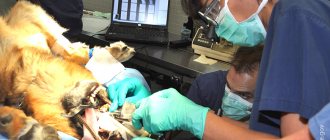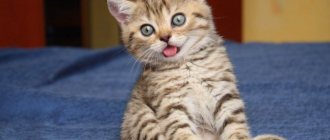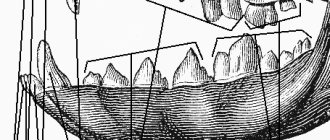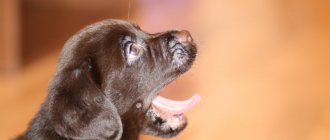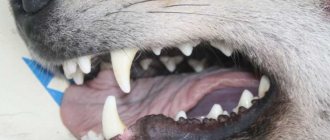Cats teeth
In most cases, kittens are born without teeth. There are exceptions to this rule, but they are extremely rare. At the age of 4-5 weeks, the kitten begins to cut its first teeth. The first set consists of 26 pieces (14 on the upper jaw and 12 on the lower jaw). As a rule, by two months the growth process is completed. By this time, healthy young cats can feed themselves and can be given solid food. They can also suckle from a cat; this usually does not cause discomfort to mothers.
Milk teeth are covered with white enamel, they themselves are sharp and quite thin. There are six incisors on the front of the jaws, followed by canines - one on each side. After them, premolars and molars grow, three on the lower jaw and two on the upper. The sequence of eruption is as follows: first the incisors appear, then the canines, and then the molars.
When the process of growth of the first, milk teeth is completed, the kittens are sent to a new place of residence (if the owner intends to do so). Before this, the first vaccinations are given and the necessary documents are completed.
It is necessary to sell or give away a kitten before the change of milk teeth to permanent ones begins.
Moving is stressful for an animal, and, in addition, during the process of replacing teeth, its body is weakened, so it is advisable to separate these two events in time. It is better for the animal if the shift begins when it has already become accustomed to its new place of residence and owners.
Formation of primary dental occlusion
Almost all mammals are born toothless. Cats are no exception: the oral apparatus of a newborn kitten is maximally adapted for effective sucking. After all, the only food available to him is mother’s milk.
At two weeks of age, kittens develop milk teeth - straight, small, sharp, milky white. In adult cats they are powerful and curved. They are called milk teeth because they appear in kittens during breastfeeding.
Interesting! The front milk teeth of kittens are straight, and the fangs are curved.
Teething order
The eruption period lasts up to two months. By this age, the cat already has 26 baby teeth. They do not appear all at once, but in a certain order:
- 2–4 weeks. Incisors appear. First, 2 in the center of the jaw, then 4 more are added to them on both sides. There are 12 incisors in total - 6 each on top and bottom.
- 3–4 weeks. Fangs appear: 4 upper and 4 lower. They are located on the sides of the incisors.
- 4–8 weeks. The appearance of pre-masticating teeth - premolars: 4 on the lower jaw and 6 on the upper jaw.
Important! Milk teeth will serve kittens up to the age of 3-4 months with proper care and timely introduction of complementary foods.
Changing teeth in kittens
At about 15-16 weeks of age, baby teeth begin to fall out and are replaced by molars. This happens in the same way as when the first set appears: first the baby teeth fall out and new incisors grow, then the lower, and then the upper canines, then the premolars and molars. The only difference is that in adult cats the full set consists of 30 teeth: 2 pieces are added on each jaw, 1 on each side.
The change process is completed at approximately seven months of age. Just like humans, cats have second molars that serve them throughout their lives. In order for them to be fully preserved in old age, the cat’s oral cavity must be properly cared for.
Doctor's advice when the process of changing teeth begins:
- After tooth loss, let your baby not eat for 3 hours, and you should also not drink very cold or hot drinks.
- Protect your child from sour, spicy and very sweet, astringent foods. All this has a negative impact on teeth.
- If your baby is bothered by discomfort or pain after a baby tooth falls out, then buy a special gel, but it is better to choose it on the recommendation of a dentist.
- Do not let your child touch the hole where a tooth has fallen out, as it may become infected.
- To soothe your mouth, make a decoction of chamomile.
Symptoms of tooth change
The owner may not notice the loss of incisors at first: they are very small. And cats are designed in such a way that they swallow small objects that end up in their mouths rather than spit them out. In addition, if the process goes well, then the kitten does not experience much discomfort and does not complain to the person.
The only normal symptom is itching of the gums, which the kitten tries to relieve by scratching them on something. During this period, wires, furniture, clothing, shoes and other things suffer. Also, teething is accompanied by copious salivation.
The appearance of permanent teeth occurs gradually. The root presses on the milky one, dissolving its weak roots in a few days. The top of the milky one falls out, and the root one begins to grow. During this period, the gums become slightly inflamed and swollen. When the permanent tooth erupts, it becomes normal.
During the period of teeth change, the kitten may show poor appetite, as it most likely experiences discomfort when chewing. In some cases, animals develop a short-term fever: the temperature rises slightly, and the cat tries to warm up, looking for warmer places.
It happens that the permanent tooth is already visible, but the milk tooth has not yet fallen out. If the latter does not interfere with the growth of the former, and the teeth do not injure the oral mucosa, then there is no need to worry. After some time, the milk will fall out. They normally do not harm each other, since they grow from separate holes.
Advice from a veterinarian-dentist
Removal of any fixed teeth, no matter whether they are temporary or permanent, must be carried out using anesthesia and analgesia. Dental pain is a moderate pain and proper analgesia is required for every patient.
To the question, is it possible to anoint the gums with something anesthetic or give them local anesthesia like in humans, I will answer right away - no, it is not possible.
Local analgesic gels will anesthetize the mucous membrane of the gums and tongue and increase salivation in the dog, which can lead to vomiting and aspiration of vomit into the trachea, and in cats their use is even more dangerous, since such gels can lead to laryngospasm and respiratory arrest. Unfortunately, a local injection into the gum cannot be carried out without the use of sedatives that induce sleep. I have a hard time imagining a cat or dog whose gum someone tries to stick a needle into. But even if this happened, after such an injection no patient will ever be allowed near him again.
Gil Veronika Yurievna, veterinarian, surgeon, dentist
https://gilvet.ru/stati/molochnye-zuby-u-sobak-i-koshek/
Captive temporary teeth, which are already being replaced by permanent teeth, are called persistent and must be removed at the first visible changes in the bite.
It is impossible to leave persistent teeth, because the dentition of an adult dog is designed for 42 teeth, and for a cat 30, and if there are more teeth, periodontitis will begin... The age for removing baby teeth is not a specific number. Everything happens individually for each animal, and to say, for example, that the optimal age is 8 months is wrong. Each animal has a different age for extraction; some require removal of persistent teeth as early as 5 months of age.
Gil Veronika Yurievna, veterinarian, surgeon
https://gilvet.ru/stati/molochnye-zuby-u-sobak-i-koshek/
In some puppies and kittens, the change of teeth occurs with an increase in body temperature and a decrease in appetite, sometimes even with a refusal to feed. In such situations, it is better to consult a doctor for help.
In cats, during the change of teeth, a very strong odor from the oral cavity is not a strong pathology, and if you see double rows of teeth (both permanent and temporary), know that this occurs normally. But if you notice that your permanent teeth are starting to grow and interfere with each other, you need to consult a specialist.
Gil Veronika Yurievna, veterinarian, surgeon, dentist
https://gilvet.ru/stati/molochnye-zuby-u-sobak-i-koshek/
If they removed temporary teeth and broke the crown, leaving the root in the gum with the words “it will resolve on its own,” I answer - no, it will not resolve.
Why should the root of a tooth dissolve because you have broken the crown? It will remain in the gums as a foreign body and at a certain time can cause the process of periodontitis of adjacent teeth or osteomyelitis of the jaw bones...
With any injury to the crown of a temporary canine, traumatic pulpitis occurs, and as a result, periodontitis develops with an abscess on the jaw, inside of which there is a rudiment of a permanent canine. Trauma, pain, inflammation and the possible loss of not only a temporary, but also a permanent canine - this is the price to pay for an incompetent attempt at self-medication.
In case of traumatic pulpitis of a temporary canine, the tooth must be immediately extracted (removed).
Gil Veronika Yurievna, veterinarian, surgeon, dentist
https://gilvet.ru/stati/molochnye-zuby-u-sobak-i-koshek/
If the temporary tooth is mobile and “almost transparent to the light”, there is no need to remove it at all - let the animal chew on something in which to sink the teeth (for example, a not very hard “chew” or a large treat), and, believe me, the tooth will fall out on its own .
Gil Veronika Yurievna, veterinarian, surgeon, dentist
gilvet.ru/stati/molochnye-zuby-u-sobak-i-koshek/
Video: cat dental care
Caring for a kitten during the period of teeth change
During the period of changing teeth, kittens' gums itch very much, just like people's gums (if adults remember this feeling). They try to chew on something to reduce the level of discomfort. At this time, owners need to be especially careful: the animal can harm itself, for example, by chewing electrical wires. There is also a danger of choking on a small object on which the kitten decided to scratch its gums. It is necessary to remove all such small items, wiring and other potentially dangerous things from the cat’s access area.
It is also necessary to pay attention to several issues: vaccination, nutrition and oral hygiene.
Nutrition
It is better to consult a veterinarian about the nutrition of a kitten during the period of teeth change. To build teeth, the animal’s body requires large amounts of calcium and phosphorus, so these elements can be slightly increased in the diet. However, you cannot overdo it: this is a serious burden on the kidneys. If parents or siblings had problems with the excretory system, then there is no need to introduce additional calcium and phosphorus.
If the kitten is accustomed to industrially produced food, then it should be fed dry food during this period. This will allow the pet to scratch its gums and, possibly, remove already loose teeth. There is no great danger in kittens swallowing teeth, but sometimes swallowed solids can harm the soft tissues of the digestive tract.
If the kitten has a natural diet, then it is recommended to give relatively large pieces of dietary meat. You can give fish twice a week, but you shouldn’t especially get used to such food. This is especially true for male kittens who are supposed to be castrated. In the future, fish will have to be completely excluded from the diet, and the animal should not get used to it.
You should also give your kitten plenty of dairy products rich in calcium. This can be cottage cheese, whole milk (if the animal tolerates it normally), yogurt, kefir with a low fat content.
In specialized stores you can find special bones that a kitten can chew on when its gums itch. In addition to the fact that it eliminates discomfort and helps teething, such products also contain useful additives that will improve the kitten’s health.
Vaccinations
Kittens should be vaccinated according to the schedule. The first vaccinations are given at two months; further procedures should be consulted with a veterinarian. As for vaccination during the period of teeth change, all veterinarians agree on this issue: while the milk teeth are falling out and the molars are growing, there is no point in getting vaccinated.
A visit to the veterinary clinic is stressful for the animal. And during the period of changing teeth, the kitten already feels somewhat weakened, even if everything is going fine. Therefore, vaccinations should be done before they begin to fall out, and then after the root ones grow.
Oral hygiene
To prevent tartar and other diseases of the oral cavity, teeth and gums, cats should brush their teeth regularly. Experts advise accustoming the animal to this procedure from infancy: then it will not experience discomfort, will get used to it and, perhaps, will even love cleaning.
Kittens need to brush their teeth with a special toothpaste and brush. Human toothpastes are not suitable for cats as they contain ingredients that are harmful to them. Each family member should have their own brush. There are also special gels for disinfecting the oral cavity for cats.
This should be done approximately once every three weeks. During the shift, you can purchase a special product containing anti-inflammatory and anesthetic components. Procedures with such a gel will significantly reduce the animal’s discomfort.
Oral care
To maintain healthy teeth for your pets, you need to follow three basic rules:
- From an early age, it is necessary to provide the kitten with a healthy, balanced diet, sufficient amounts of minerals and vitamins. The veterinarian will help you choose food in accordance with the age and physiological characteristics of the cat. Cleaning of the incisors occurs naturally: when the animal chews solid food. That’s why the presence of dry food and large pieces in a cat’s diet is so important. Mechanical action on the surface of the teeth cleanses them of plaque and protects them from the formation of tartar.
- Compliance with the rules of basic oral hygiene. The list of kitten care procedures should include mandatory cleaning. Baby teeth can be cleaned with a soft cloth. The kitten will enjoy this procedure if a special paste for cats is applied to the fabric - it has a pleasant smell and taste. Changing incisors can be cleaned with a brush: the kitten will happily chew on the soft bristles, which will help cope with the itching. As your permanent teeth grow in, you can move on to brushing with a stiffer bristled brush. The procedure is carried out with light movements from roots to ends. Regularity – 2–3 times a week.
- Constant availability of sufficient clean water.
If tartar or other pathologies appear, you should contact your veterinarian. The treatment takes place under anesthesia, so there is no need to worry about the moral and emotional state of your pet.
Self-examinations conducted by the owner and regular visits to the veterinarian will help raise a strong, beautiful pet and maintain the health of its teeth for a long time. Regularity is important - this will allow you to identify problems in time and help the animal.
In what cases is it necessary to contact a veterinarian?
The change of teeth occurs gradually, and it is necessary to regularly examine the kitten’s oral cavity. If the gums are pink, there is no inflammation or redness in the places where soft tissue joins the bone, and baby teeth do not interfere with the growth of permanent teeth, then there is no reason to worry. You should contact your veterinarian if you notice the following problems:
- there is redness around the baby tooth or the hole where it was located;
- pus appeared in the hole from the fallen tooth;
- a very strong unpleasant odor comes from the mouth;
- there is inflammation on the gums;
- the new tooth grows in such a way that it damages the mucous membrane, due to the fact that it is interfered with by the milk tooth or for another reason;
- The radical ones have grown, but the milk ones have not completely fallen out, and the shift time has ended.
You should also pay attention to the well-being and behavior of your pet. Warning signs:
- the kitten is apathetic, does not play;
- a plaintive meow, indicating serious discomfort and pain;
- the animal eats poorly or refuses to eat at all;
- anxiety, poor sleep.
Sometimes owners notice that the tray is empty for more than a day. This is also a cause for concern. The absence of bowel movements may be due to the fact that the kitten was trying to scratch its teeth and swallowed some object that blocked the intestinal lumen.
The owner should be aware that during the period of changing teeth, kittens' immune defenses are somewhat reduced, so changes in behavior may be due to the fact that the animal has contracted an infection. This can also happen to a kitten who lives in the house and is not outside. Owners can bring pathogenic flora into the apartment on shoes or clothes. Usually it is not dangerous for either animals or humans, however, against the background of a decrease in the immune status, the cat may get sick. Not everyone has been vaccinated by this age, and the animal does not have specific immunity to certain pathogens.
Changing baby teeth to permanent ones
At the age of three months, kittens begin to lose their milk teeth, gradually being replaced by molars . This process is usually complete by six or seven months, but don't worry if it takes longer for your kitten. Such deviations are usually associated with the breed of cat or characteristics of individual development.
The order of changing teeth should not be disturbed. The first to be replaced are the incisors, then the canines, and lastly the molars and premolars are replaced.
However, if a new tooth grows on a baby tooth and this causes discomfort to the pet, then you should definitely consult a specialist. If such growth does not bother the animal, then a visit to the veterinarian can be postponed, since baby teeth can calmly and painlessly fall out even after the main shift.
Teeth change schedule
A healthy adult cat should have thirty permanent teeth: twelve incisors, four canines, ten premolars and four molars. Each of them serves her for a specific purpose, for example, incisors are needed to tear food, fangs help to capture prey, and so on.
A cat's permanent dental formula is formed after six months. It includes: on top - three incisors, one canine, three premolars, one molar; below - three incisors, one canine, two premolars, one molar. When calculating, all coefficients are doubled, so the total is thirty permanent teeth.
This is what the jaw of an adult healthy cat should look like with timely and correct teeth replacement.
Table: schedule for the eruption of permanent teeth and their functions
| Teeth | Quantity (lower/upper jaw) | Period of eruption | Function |
| Incisors | 6/6 | 3.5–4.5 months | Grabbing |
| Fangs | 2/2 | 5 months | Tearing |
| Premolars | 6/4 | 4.5–6 months | Chopping |
| Molars | 2/2 | 4–5 months | Chopping |
Symptoms of tooth change
The process of changing teeth can begin and even end unnoticed by you, since the kitten usually does not experience pain. Most often, the change of teeth becomes obvious when a lost baby tooth is found.
Nevertheless, there are a number of symptoms that will help you navigate and notice in time the process of changing teeth:
- When a kitten's teeth change, an unpleasant odor may appear from the mouth, which is often associated with poor nutrition. There is no need to do anything about this, it will quickly disappear once the teeth renewal process is completed.
- Kittens may experience discomfort during the actual cutting of new teeth, so the animal's behavior will change slightly. For example, a slight increase in temperature is likely (the norm is a temperature of 38 ° C to 39 ° C, for small kittens a higher temperature of up to 39.5 ° C is typical). As a result, the kitten feels the cold more strongly and tries to spend more time next to the warm body of the owner: on the lap or in the arms. At night, pets can crawl under the covers, even if this was previously uncharacteristic for them.
If your pet suddenly loves lying under a blanket, this may be a sign of discomfort when changing teeth.
- You need to carefully ensure that the kitten does not swallow a lost tooth while eating. If this happens, you should not immediately run to the veterinarian; usually the tooth comes out naturally. However, it can also get stuck in the intestines, causing pain. The kittens then become aggressive and their temperature rises. In this case, you need to contact a specialist.
- During the period of teeth change, the pet will more often try to taste everything or chew on it in order to get rid of loose teeth.
Be very careful that your kitten does not start chewing wires or other objects that could harm him.
- From this moment on, cats begin to mark their territory.
- Redness of the gums may be observed, which is better to contact a specialist immediately so that chronic inflammation of the oral cavity does not begin.
- Sore gums can lead to refusal to eat. This is not a big deal, but if it lasts more than one to two days at most, you should change dry food to wet food, consulting your veterinarian first.
The author of these lines recently encountered the process of changing teeth in his kitten. Each animal exhibits specific symptoms, and when problems arise, it is easy for owners who know their animals to notice changes in behavior. So, my kitten usually did not hide under the blanket and did not play with some toys. When his teeth changed, he constantly chewed rubber sticks and tried to bite the scratching post. In this case, the baby teeth did not fall out immediately, but after the fangs were replaced.
Video: kitten teeth falling out
What to do and how to relieve the kitten’s discomfort?
It is recommended to buy special chewing toys for the kitten during the change of teeth.
When pets change their teeth, they often experience pain that does not allow them to live their previous lives. If a cat’s fang or molars are protruding, then to alleviate the discomfort, owners are advised to purchase special rodents or bones from the pet store, on which the animal can scratch its gums. For this reason, as soon as a kitten’s tooth falls out, it is worth removing all electrical appliances, shoes and other items that the baby can damage. If a cat experiences increased salivation when changing teeth, then no measures should be taken. In most cases, this symptom does not cause discomfort to the kitten. If his face is constantly wet, then periodically it can be wiped with a soft cloth or dry cloth.
When a kitten's teeth grow, its body may be constantly in a state of stress. Owners are advised to treat the baby with special attention, surround him with love, care and attention. Frequent contact with your pet and various games will distract him from changing teeth and reduce discomfort. During this process, the pet often rubs against the corners of furniture or the owner’s legs. You shouldn’t forbid him to do this, because with such actions he is trying to calm himself down and scratch his gums. It is also important to pay attention if these signs are not observed, as they may indicate a problem, so it is recommended to take the kitten to the vet.

